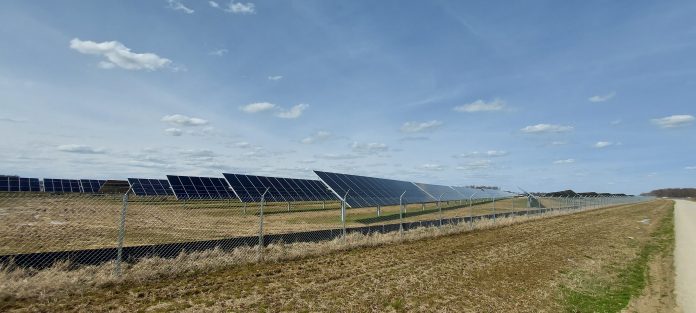Several regions of Ohio have seen large tracts of farmland take on a new type of production where yields are to be measured in megawatts instead of bushels.
Solar energy production increased in Ohio over the last several years and according to the Ohio Power Sitting Board, there are a total of 35 photovoltaic solar projects that have been submitted to board that spread over more than 60,000 acres.
Projects range from a few hundred acres to over 2,000 acres of land. The length of these contracts, 30 years or more, have raised questions about the long-term soil health and environmental impacts caused by these developments. What can be done to ease the transition back to farmland after the contract is expired and what practices can be done now to mitigate the impacts to drainage and wildlife?
A team from Ohio State University Extension, including myself, Noble County extension educator, Christine Gelley and energy development field specialist, Eric Romich, is working on a fact sheet titled “Forage as a Vegetative Cover for Utility Scale Solar in Ohio.”
Instead of leaving the surface uncovered, or using gravel and turfgrasses, cool-season forages can be used to offer several environmental and economic benefits.
Regardless of the species grown, height requirements become very important as plants should not become overgrown and shade the panels. Each developer will have their own restrictions outlined in the agreement, but plant heights are typically restricted to less than 3 feet. Given this restriction, mowing and maintenance will be required regardless of the type of vegetation grown.
Therefore, cool-season forages offer the opportunity for hay to be harvested from these routine cuttings. Of course, navigating machinery between the rows of panels can be a challenge. We are currently cooperating with landowners and developers to determine what equipment and practices are most suitable for harvesting hay at these locations.
Cool-season pasture and hay mixes typically contain a variety of perennials that can provide ground cover all year long. Kentucky bluegrass, tall fescue, orhcardgrass, perennial ryegrass and reed canarygrass are some cool-season grasses that are often included in mixes and perform well in Ohio.
Using legumes, like alfalfa, birdsfoot trefoil and clover, in these mixes can also add to the soil health benefits through their ability to fix additional nitrogen which can be returned to the soil through plant residue.
As stated in the Ohio Agronomy Guide, mixes that include alfalfa, birdsfoot trefoil, perennial ryegrass, Kentucky bluegrass and most clover varieties will reach mature heights of 3 feet. Without harvesting, other species such as orhcardgrass, tall fescue, and reed canarygrass can reach heights of up to 5 feet.
Depending on growing conditions and species included in a mix, one could expect to harvest two to four times per year to maintain sward height below solar panel interference and to provide quality forage for livestock consumption.
A mix that includes clover and other flowering legumes can also provide pollinator benefits. Our upcoming fact sheet will have additional information on specific species qualities such as maximum mature height, acidic soil tolerance, seeding rate, seeding depth and other site suitability considerations.
Grazing sheep
Another practice that has been used in Ohio is grazing sheep within areas of the solar field. Sheep are the preferred livestock to utilize as they are less likely to cause damage but are still effective at grazing areas under the solar panels. Additional information, webinars and research reports about solar grazing can be found on the American Solar Grazing Association’s website at solargrazing.org.
Pollinator mixes
One other trend in Ohio is the use of pollinator mixes as a ground cover. While these mixes can be an attractive option for their aesthetic appeal and pollinator benefits, weed control is an anticipated challenge.
This is especially true in crop fields that have history of noxious weed populations. Plants that are listed on the Ohio noxious weed list must be controlled. It is common practice to utilize controlled burns to manage weeds in pollinator plots, but this is not practical in a solar field setting. Therefore, spot spraying with herbicides or hand rouging is necessary.
There are several important factors to consider before deciding on the cover to be used. Decisions will depend on the flexibility and goals of landowners and developers.
More information will be available in our “Forage as a Vegetative Cover for Utility Scale Solar in Ohio” factsheet in the coming months. Once released, the factsheet can be found at ohioline.osu.edu. Numerous guides and resources on solar leasing can be found at go.osu.edu/tipsonsolarleasing.














What conditions are being put in these solar contracts for end of life of the panels. I heard of current #’s being $48 to recycle a panel to salvage $3 worth of silver and rare earths. So, all current defunct panels are going to land fill.